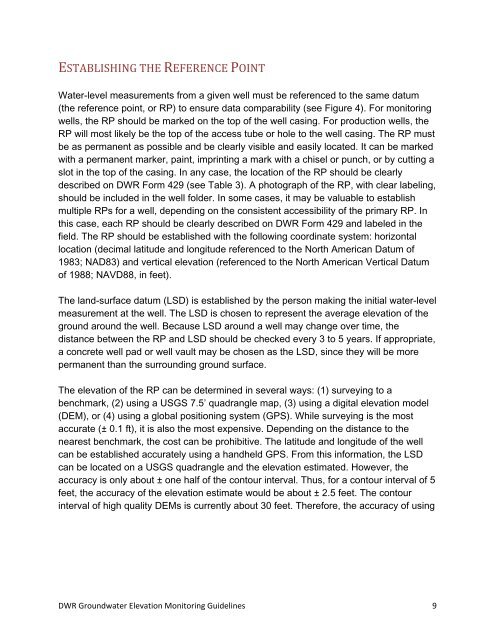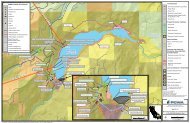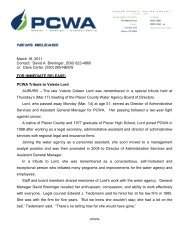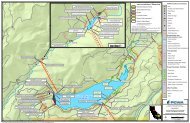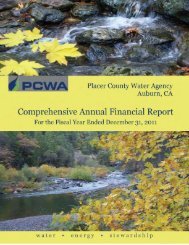Martis Valley Groundwater Management Plan - Placer County Water ...
Martis Valley Groundwater Management Plan - Placer County Water ...
Martis Valley Groundwater Management Plan - Placer County Water ...
Create successful ePaper yourself
Turn your PDF publications into a flip-book with our unique Google optimized e-Paper software.
ESTABLISHING THE REFERENCE POINT<br />
<strong>Water</strong>-level measurements from a given well must be referenced to the same datum<br />
(the reference point, or RP) to ensure data comparability (see Figure 4). For monitoring<br />
wells, the RP should be marked on the top of the well casing. For production wells, the<br />
RP will most likely be the top of the access tube or hole to the well casing. The RP must<br />
be as permanent as possible and be clearly visible and easily located. It can be marked<br />
with a permanent marker, paint, imprinting a mark with a chisel or punch, or by cutting a<br />
slot in the top of the casing. In any case, the location of the RP should be clearly<br />
described on DWR Form 429 (see Table 3). A photograph of the RP, with clear labeling,<br />
should be included in the well folder. In some cases, it may be valuable to establish<br />
multiple RPs for a well, depending on the consistent accessibility of the primary RP. In<br />
this case, each RP should be clearly described on DWR Form 429 and labeled in the<br />
field. The RP should be established with the following coordinate system: horizontal<br />
location (decimal latitude and longitude referenced to the North American Datum of<br />
1983; NAD83) and vertical elevation (referenced to the North American Vertical Datum<br />
of 1988; NAVD88, in feet).<br />
The land-surface datum (LSD) is established by the person making the initial water-level<br />
measurement at the well. The LSD is chosen to represent the average elevation of the<br />
ground around the well. Because LSD around a well may change over time, the<br />
distance between the RP and LSD should be checked every 3 to 5 years. If appropriate,<br />
a concrete well pad or well vault may be chosen as the LSD, since they will be more<br />
permanent than the surrounding ground surface.<br />
The elevation of the RP can be determined in several ways: (1) surveying to a<br />
benchmark, (2) using a USGS 7.5’ quadrangle map, (3) using a digital elevation model<br />
(DEM), or (4) using a global positioning system (GPS). While surveying is the most<br />
accurate (± 0.1 ft), it is also the most expensive. Depending on the distance to the<br />
nearest benchmark, the cost can be prohibitive. The latitude and longitude of the well<br />
can be established accurately using a handheld GPS. From this information, the LSD<br />
can be located on a USGS quadrangle and the elevation estimated. However, the<br />
accuracy is only about ± one half of the contour interval. Thus, for a contour interval of 5<br />
feet, the accuracy of the elevation estimate would be about ± 2.5 feet. The contour<br />
interval of high quality DEMs is currently about 30 feet. Therefore, the accuracy of using<br />
DWR <strong>Groundwater</strong> Elevation Monitoring Guidelines 9


